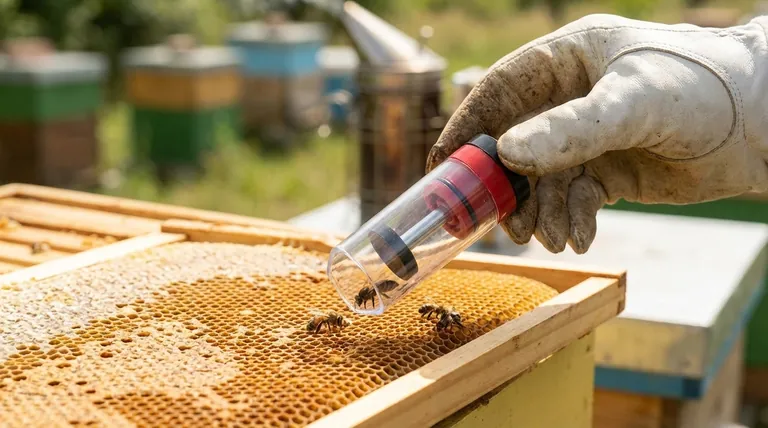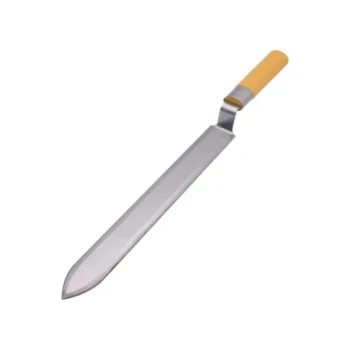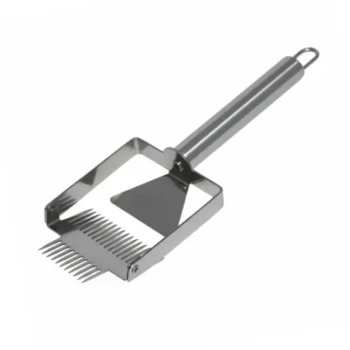In beekeeping, a queen catcher is a specialized tool designed for one critical purpose: to safely and temporarily immobilize the queen bee. It is typically a small plastic clip or box with a gentle, spring-loaded mechanism that allows a beekeeper to secure the queen without causing her harm, making tasks like inspection, marking, or relocation much safer for the most important member of the colony.
A queen catcher is for the temporary, on-site handling of a queen bee. Understanding its function is the first step toward mastering the broader and more critical beekeeping discipline of queen management, which is essential for maintaining a healthy and productive hive.

Catcher vs. Cage: Clarifying the Tools
While often discussed together, it's vital to distinguish between a queen catcher (or clip) and a queen cage. They serve different, though related, functions in queen management.
The Queen Catcher: For Short-Term Handling
A queen catcher is designed for immediate, short-term use directly at the hive. Its primary job is to gently trap the queen on the surface of a frame.
This allows the beekeeper to hold her securely for a few moments, preventing her from running, flying away, or being accidentally crushed during an inspection.
The Queen Cage: For Introduction and Transport
A queen cage is a small box, often made of wood or plastic, used for longer-term containment. It is used to transport a new queen or to introduce her to a new colony.
The cage protects the new queen from the colony's workers, who would otherwise see her as an intruder and kill her. A small candy plug in the cage is slowly eaten by the bees, allowing them to acclimate to her pheromones and accept her gradually over several days.
Why You Need to Handle the Queen
Handling the queen is a high-stakes task, but it is necessary for several core beekeeping operations that ensure the long-term health and productivity of the hive.
For Safe Hive Inspections
Finding the queen is a key part of any thorough hive inspection. A queen catcher allows you to isolate her safely while you inspect the brood pattern or check the health of the rest of the frame.
By securing her, you eliminate the risk of accidentally rolling or squashing her as you manipulate frames—an accident that could set the colony back for weeks.
For Marking the Queen
Many beekeepers mark their queens with a small dot of non-toxic paint. This makes her vastly easier to find in a colony of tens of thousands of other bees.
A queen catcher holds her still, providing a stable platform to apply the paint dot accurately on her thorax without causing her stress or injury. A marked queen saves significant time and effort during future inspections.
For Requeening a Colony
When a queen is old, failing, or has poor genetics, the beekeeper must replace her—a process called requeening.
A queen catcher is the perfect tool to find and safely remove the old queen from the hive. The new queen is then introduced using a queen cage to ensure a safe and gradual acceptance by the colony.
Understanding the Risks and Trade-offs
While essential, using a queen catcher is not without risk. The queen is the single most valuable individual in the colony, and any harm to her can have severe consequences.
The Risk of Injury
Even with a well-designed tool, there is always a small chance of injuring the queen's legs, wings, or abdomen if you are not careful. Haste or a lack of confidence are the primary causes of accidents.
Always operate the catcher slowly and deliberately. Ensure you are only trapping her thorax (the middle section of her body) and that her legs are clear.
The Stress on the Queen and Colony
Being captured, even briefly, can be stressful for the queen. This stress can temporarily interrupt her egg-laying.
For this reason, you should only catch the queen when absolutely necessary. Routine inspections to simply confirm her presence do not require her to be caught. Reserve this for tasks like marking or removal.
Applying This to Your Beekeeping
Your need for a queen catcher or cage depends entirely on the task at hand. Understanding the right tool for the job is fundamental to successful queen management.
- If your primary focus is a quick inspection: Use a queen catcher to briefly isolate the queen to prevent her from getting lost or hurt while you work.
- If your primary focus is marking the queen: A queen catcher is the ideal tool to hold her steady for a safe and accurate application of paint.
- If your primary focus is introducing a new queen: You must use a queen cage to protect her and allow the colony to accept her over several days.
Ultimately, mastering these tools is about becoming a more confident, precise, and effective beekeeper.
Summary Table:
| Tool | Primary Use | Duration |
|---|---|---|
| Queen Catcher | Short-term handling, inspection, marking | Minutes (on-site) |
| Queen Cage | Introduction, transport, requeening | Days (off-site) |
Master queen management with the right tools from HONESTBEE.
As a commercial apiary or beekeeping equipment distributor, efficient and safe queen handling is critical for your operation's productivity and hive health. HONESTBEE supplies durable, precision-engineered queen catchers and a full range of beekeeping equipment designed for professional use.
Let us help you minimize risk and maximize efficiency. Contact our wholesale team today to discuss your equipment needs and volume pricing.
Visual Guide

Related Products
- Plastic Queen Bee Catcher Marker Tube Holder for Queen Marking Bottle
- Queen Bee Marking Tube Cage Bottle Catcher Holder with Clear Plastic Plunger Marker
- Double Head Beekeeping Grafting Tools for Beekeepers
- Plastic Chinese Queen Grafting Tool for Bee Queen Rearing
- Professional Dual-End Stainless Steel Hive Tool for Beekeeping
People Also Ask
- How can queen marking benefit small-scale beekeepers? Boost Efficiency & Hive Health
- What precautions should be taken when using a one-handed queen catcher? Safely Capture and Mark Your Queen
- What tools and skills are needed to mark a queen bee? Master the Art of Safe & Effective Queen Marking
- What is the goal of queen marking? Boost Hive Management Efficiency & Colony Health
- When is the best time to mark a queen bee? Ensure Colony Success with Proper Timing



















